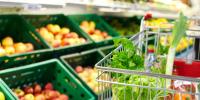Good news for fish-eaters in update of the Big Climate Database

New insights into the climate impact of several different types of fish make it even more attractive to choose fish instead of red meat when aiming for a climate friendly meal. Fish is already included in the Danish Official Dietary Guidelines, where one of the key recommendations is: Eat less meat – choose legumes and fish.
“Beef still has a significantly higher climate impact than any other food, and originally, fish had a relatively high climate impact in the database as well. However, due to new information about energy consumption and fodder use in aquaculture production, the climate impact from consuming fish is now significantly lower. This further means, that the climate benefit of following the official dietary guidelines is greater than first anticipated,” says program director Michael Minter, CONCITO.
One of the most significant changes in version 1.1 of the Big Climate Database is the markedly reduced climate impact of fish. For example, the climate impact of consuming wild Atlantic salmon has been reduced by 68%, from 9.5 kg CO2e/kg to 2.9 kg CO2e/kg, and herring has been reduced by 67%, from 9.3 kg CO2e/kg to 3.1 kg CO2e/kg. This means that the climate impact of fish is now similar to chicken and pork.
Average beef has a climate impact of 61 kg CO2e/kg, while average pork has a climate impact of 4.7 kg CO2e/kg, and chicken has a climate impact of 3.3 kg CO2e/kg.
“Roughly calculated, the climate impact of beef is 13 times higher than pork, 18 times higher than chicken and fish, and more than 100 times higher than many fruits and vegetables. So, it does make a big difference for the climate what food you choose,” Michael Minter emphasizes.
No time to waste in the transition of Danes’ dietary habits
In April 2022, it was decided that Denmark should have a government-controlled climate label, and one year later, the Climate Label working group presented their recommendations for the upcoming climate label to the Minister of Food. The final realization of the climate label requires further work on the development of a government database for the generic climate impact of foods, and the label is not expected to be applicable until 2025 at the earliest. In the meantime, stakeholders in the food sector should continue their data-driven efforts to promote more climate friendly diets.
“The green transition of Danes’ dietary habits should not be put on hold while waiting for a government-based climate database. On the contrary, it should be further encouraged and promoted. Therefore, the food actors should continue to gain insights and experience in climate calculations of purchases and meals based on the current available and preferred databases, including the new version of the Big Climate Database”, urges Michael Minter, program director in CONCITO.
The Big Climate Database version 1.1, as well as an English summary of the corresponding background report from CONCITO and methodology report from 2.-0 LCA consultants, is available in both Danish and English on the website denstoreklimadatabase.dk/en. Here, it is also possible to find a new version developed by 2.-0 LCA consultants for the British market. In 2025, the results from the Big Climate Database will be developed and disseminated further through Aalborg University’s Getting the Data Right-project, which is a part of the 70i30-project.
Further information
Michael Minter, Program Director for Food and consumption, mm@concito.dk, +45 26 16 64 14
About the Big Climate Database
Version 1 of the Big Climate Database was launched in February 2021. In the new version 1.1, changes and corrections have been made based on feedback from food producers and users of the climate database, as well as new scientific insights, including new data and emission factors for agriculture.
In addition to updates and corrections of the results for the original 500 food types, version 1.1 includes new results for average beef, pork, and chicken, as requested by many users. Furthermore, changes in product names and categories have been made to make it easier to search and navigate the database.
The climate impact of the 503 foods is provided in kg CO2 equivalents (CO2e) per kg of product (net weight) and expresses the future global climate consequence of consuming different types of food. CO2e includes the climate impact from the emission of CO2 and other greenhouse gases such as methane and nitrous oxide, as well as the indirect land use change caused by the food production.

